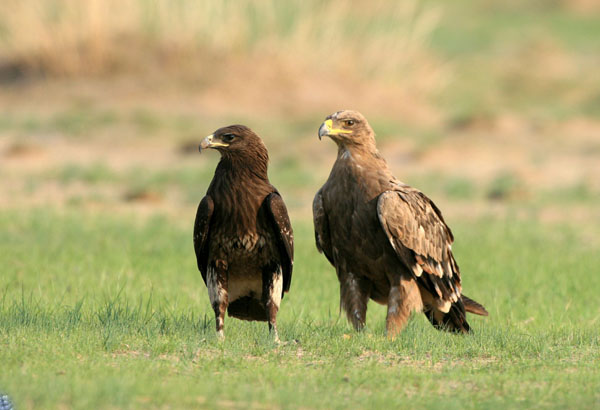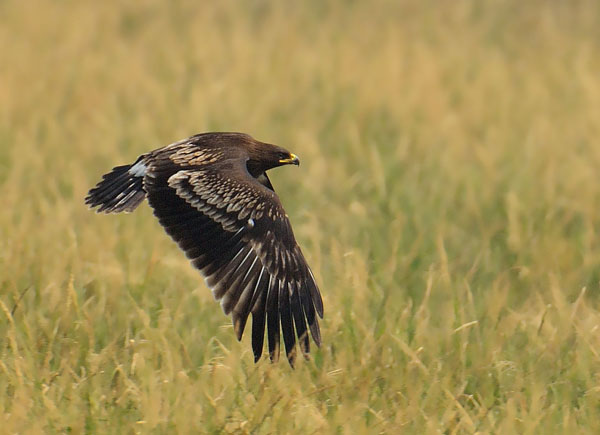Clanga clanga
IUCN
LCBasic Information
Scientific classification
- name:Clanga clanga
- Scientific Name:Wu Diao, Hua Diao, Tas, Wu Xiao Ni, Xiao Hua Zao Diao
- Outline:Raptor
- Family:Accipitriformes Accipitridae Clanga
Vital signs
- length:61~74cm
- Weight:1.310~2.100kg
- lifetime:20year
Feature
It lives in open wilderness areas during migration and is one of the most likely birds of prey to be spotted along the migration routes in eastern Asia.
Distribution and Habitat
In my country, it breeds in the northeast and northwest. It passes through most of China during migration, and a small number of individuals overwinter in the southwest and south China. Abroad, it is distributed in Siberia, the Russian Far East and Mongolia, and overwinter in the Indian subcontinent, Indochina, the Arabian Peninsula and the east of the Sahara Desert in Africa.
The black eagle inhabits forests in low mountains, hills and open plains, especially sparse forests and plain forests in rivers, lakes and swamps. It also appears in plain grasslands and forest edges near waters, and sometimes enters coniferous forests along river valleys. It inhabits open areas during migration.
Appearance
A medium to large raptor. The sexes are monotypic. The wing fingers are 7. It is a relatively small bird of prey. Adults are dark brown almost black, with a faint crescent-shaped light area at the base of the primary flight feathers under the wings. Immature birds have irregular small light spots on their bodies, and two white bands composed of white spots on the back and wings, as well as some irregular white spots, which are quite unique. This species has white upper tail coverts, also known as "white waist", which are easy to observe when it is perched.
Details
The black eagle is a national first-class protected animal. Its body is dark brown, with a slight purple luster on its back. Its chin, throat and chest are dark brown, and the rest of its lower body is slightly lighter. The breeding season of the black eagle is from May to July. It nests on pine trees, oak trees or other tall trees in the forest, about 8 to 20 meters above the ground, sometimes even up to 25 meters. The structure of the nest is relatively large, mainly composed of dead branches, with twigs and fresh small branches and leaves inside. The structure is relatively simple and flat.

The black eagle is active during the day and is solitary. It often stands on the treetops for a long time, and sometimes hovers over the edge of the forest and the forest. It often hunts in flight or lying on the ground, and sometimes hovers over the edge of the forest and the forest. The call is low-pitched and clear. It mainly feeds on small animals such as hares, mice, wild ducks, frogs, lizards, fish and birds, and sometimes eats animal carcasses and large insects. They forage mostly in forest clearings, swamps, rivers and lakes. They often hover over forest swamps and river valleys to forage. They also wait for a long time at high places such as treetops, constantly watching the ground, and suddenly attack when they find prey.

A study from Russia analyzed the composition ratio of 357 prey: nearly 60% are mammals, 30% are birds, and 10% are amphibians, reptiles and carrion. They will also actively plunder the nests of other birds, such as herons, egrets, and red-billed gulls, and kill them before the young birds mature.
The main factors that endanger the black eagle are deforestation over the years and frequent human economic activities. The habitat of the black eagle has been destroyed, the vast feeding ground has been shrinking, and the population has dropped sharply. The reason for the endangered black eagle is that on the one hand, the grassland rodent control and the use of a lot of pesticides have enriched the black eagle, which mainly feeds on rodents, with highly toxic pesticides, causing the second poisoning or laying deformed eggs or hatching failures; another reason is hunting by local hunters.
In March 1996, Jilin Province proposed a five-year hunting ban, and the population is expected to gradually recover.








